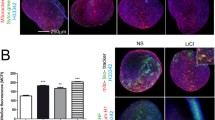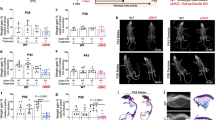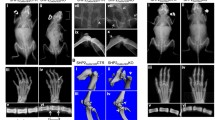Abstract
This study aimed to investigate whether inhibition of glycogen synthase kinase-3β (GSK-3β) could promote chondrocytes proliferation. The expression pattern of GSK-3β was firstly determined by immunohistochemistry (IHC) in normal mouse. Tibias were then isolated and cultured for 6 days. The tibias were treated with dimethylsulfoxide (control) or GSK-3 inhibitor SB415286 (SB86). Length of tibias was measured until 6 days after treatment. These bones were either stained with alcian blue/alizarin red or analyzed by IHC. In addition, GSK-3β and β-catenin were analyzed by Western blot. Finally, cartilage-specific GSK-3β deletion mice (KO) were generated. Efficiency of GSK-3β deletion was determined through Western blot and IHC. After treated by inhibitor SB86, the overall length of growth plate was not changed. However, growth of tibia in SB86 group was increased by 31 %, the length of resting and proliferating was increased 13 % (P < 0.01), whereas the length of hypertrophic was decreased by 57 % (P < 0.01). Besides, the mineralized length was found to be significant longer than the control group (P < 0.05). In KO mice, growth plate and calvaria tissue both exhibit significant reduction of GSK-3β (P < 0.05) whereas the lengths of tibias in KO were almost same compared with control mice. Finally, an increase amount of β-catenin protein was observed in SB86 (P < 0.05). In addition, significantly increased β-catenin was also found in the growth plate of KO mice (P < 0.05). Inhibition of GSK-3 could promote longitudinal growth of bone through increasing bone formation. Besides, the inactivation of GSK-3β could lead to enhancing β-catenin, therefore promote chondrocytes proliferation.




Similar content being viewed by others
References
Baron R, Rawadi G (2007) Targeting the Wnt/β-catenin pathway to regulate bone formation in the adult skeleton. Endocrinology 148(6):2635–2643
Bhukhai K, Suksen K, Bhummaphan N, Janjorn K, Thongon N, Tantikanlayaporn D, Piyachaturawat P, Suksamrarn A, Chairoungdua A (2012) A phytoestrogen diarylheptanoid mediates estrogen receptor/Akt/glycogen synthase kinase 3β protein-dependent activation of the Wnt/β-catenin signaling pathway. J Biol Chem 287(43):36168–36178
Boku S, Nakagawa S, Masuda T, Nishikawa H, Kato A, Kitaichi Y, Inoue T, Koyama T (2009) Glucocorticoids and lithium reciprocally regulate the proliferation of adult dentate gyrus-derived neural precursor cells through GSK-3beta and beta-catenin/TCF pathway. Neuropsychopharmacology 34(3):805–815. doi:10.1038/npp.2008.198
Canalis E (2009) Growth factor control of bone mass. J Cell Biochem 108(4):769–777
Choi Y, Kang SS, Jin EJ (2009) BMP-2 treatment of C3H10T1/2 mesenchymal cells blocks MMP-9 activity during chondrocyte commitment. Cell Biol Int 33(8):887–892
Dao DY, Jonason JH, Zhang Y, Hsu W, Chen D, Hilton MJ, O’Keefe RJ (2012) Cartilage-specific β-catenin signaling regulates chondrocyte maturation, generation of ossification centers, and perichondrial bone formation during skeletal development. J Bone Miner Res 27(8):1680–1694
Day TF, Guo X, Garrett-Beal L, Yang Y (2005) Wnt/β-catenin signaling in mesenchymal progenitors controls osteoblast and chondrocyte differentiation during vertebrate skeletogenesis. Dev Cell 8(5):739–750
Fan Z, Tardif G, Hum D, Duval N, Pelletier J-P, Martel-Pelletier J (2009) Hsp90β and p130cas: novel regulatory factors of MMP-13 expression in human osteoarthritic chondrocytes. Ann Rheum Dis 68(6):976–982
Fioravanti A, Collodel G, Petraglia A, Nerucci F, Moretti E, Galeazzi M (2010) Effect of hydrostatic pressure of various magnitudes on osteoarthritic chondrocytes exposed to IL-1β. Indian J Med Res 132:209–217
Foldager CB, Nielsen AB, Munir S, Ulrich-Vinther M, Søballe K, Bünger C, Lind M (2011) Combined 3D and hypoxic culture improves cartilage-specific gene expression in human chondrocytes. Acta Orthop 82(2):234–240
Fortier LA, Motta T, Greenwald RA, Divers TJ, Mayr KG (2010) Synoviocytes are more sensitive than cartilage to the effects of minocycline and doxycycline on IL-1α and MMP-13-induced catabolic gene responses. J Orthop Res 28(4):522–528
Hill TP, Später D, Taketo MM, Birchmeier W, Hartmann C (2005) Canonical Wnt/β-catenin signaling prevents osteoblasts from differentiating into chondrocytes. Dev Cell 8(5):727–738
Im HJ, Kim JS, Li X, Kotwal N, Sumner DR, van Wijnen AJ, Davis FJ, Yan D, Levine B, Henry JL (2010) Alteration of sensory neurons and spinal response to an experimental osteoarthritis pain model. Arthritis Rheum 62(10):2995–3005
Kulkarni NH, Wei T, Kumar A, Dow ER, Stewart TR, Shou J, N’cho M, Sterchi DL, Gitter BD, Higgs RE (2007) Changes in osteoblast, chondrocyte, and adipocyte lineages mediate the bone anabolic actions of PTH and small molecule GSK-3 inhibitor. J Cell Biochem 102(6):1504–1518
Lewis R, Feetham CH, Barrett-Jolley R (2011) Cell volume regulation in chondrocytes. Cell Physiol Biochem 28(6):1111–1122
Maeda S (2011) An impact of CCN2–BMP-2 complex upon chondrocyte biology: evoking a signalling pathway bypasses ERK and Smads? J Biochem 150(3):219–221
Majumdar MK, Chockalingam PS, Bhat RA, Sheldon R, Keohan C, Blanchet T, Glasson S, Morris EA (2008) Immortalized mouse articular cartilage cell lines retain chondrocyte phenotype and respond to both anabolic factor BMP-2 and pro-inflammatory factor IL-1. J Cell Physiol 215(1):68–76
Moon RT, Bowerman B, Boutros M, Perrimon N (2002) The promise and perils of Wnt signaling through β-catenin. Science 296(5573):1644–1646
Naves MA, Requião-Moura LR, Soares MF, Silva-Júnior JA, Mastroianni-Kirsztajn G, Teixeira V (2011) Podocyte Wnt/ß-catenin pathway is activated by integrin-linked kinase in clinical and experimental focal segmental glomerulosclerosis. J Nephrol 25(3):401–409
Nogami M, Tsuno H, Koike C, Okabe M, Yoshida T, Seki S, Matsui Y, Kimura T, Nikaido T (2012) Isolation and characterization of human amniotic mesenchymal stem cells and their chondrogenic differentiation. Transplantation 93(12):1221–1228
Nurminskaya M, Magee C, Faverman L, Linsenmayer TF (2003) Chondrocyte-derived transglutaminase promotes maturation of preosteoblasts in periosteal bone. Dev Biol 263(1):139–152
Oseni AO, Butler PE, Seifalian AM (2013) Optimization of chondrocyte isolation and characterization for large-scale cartilage tissue engineering. J Surg Res 181(1):41–48
Park S-I, Lee H-R, Kim S, Ahn M-W, Do SH (2012) Time-sequential modulation in expression of growth factors from platelet-rich plasma (PRP) on the chondrocyte cultures. Mol Cell Biochem 361(1–2):9–17
Pasco MY, Catoire H, Parker JA, Brais B, Rouleau GA, Néri C (2010) Cross-talk between canonical Wnt signaling and the sirtuin-FoxO longevity pathway to protect against muscular pathology induced by mutant PABPN1 expression in C. elegans. Neurobiol Dis 38(3):425–433
Primot A, Baratte B, Gompel M, Borgne A, Liabeuf S, Romette J-L, Jho E-H, Costantini F, Meijer L (2000) Purification of GSK-3 by affinity chromatography on immobilized axin. Protein Expr Purif 20(3):394–404
Pulkkinen HJ, Tiitu V, Valonen P, Jurvelin J, Rieppo L, Töyräs J, Silvast T, Lammi M, Kiviranta I (2012) Repair of osteochondral defects with recombinant human type II collagen gel and autologous chondrocytes in rabbit. Osteoarthr Cartil 21(3):481–490
Reinhold MI, Kapadia RM, Liao Z, Naski MC (2006) The Wnt-inducible transcription factor Twist1 inhibits chondrogenesis. J Biol Chem 281(3):1381–1388
Steinert AF, Rackwitz L, Gilbert F, Nöth U, Tuan RS (2012) Concise review: the clinical application of mesenchymal stem cells for musculoskeletal regeneration: current status and perspectives. Stem Cells Transl Med 1(3):237–247
Studer D, Millan C, Ozturk E, Maniura-Weber K, Zenobi-Wong M (2012) Molecular and biophysical mechanisms regulating hypertrophic differentiation in chondrocytes and mesenchymal stem cells. Eur Cell Mater 24(24):118–135
Taipaleenmäki H, Abdallah BM, AlDahmash A, Säämänen A-M, Kassem M (2011) Wnt signalling mediates the cross-talk between bone marrow derived pre-adipocytic and pre-osteoblastic cell populations. Exp Cell Res 317(6):745–756
Toh WS, Lee EH, Guo X-M, Chan JK, Yeow CH, Choo AB, Cao T (2010) Cartilage repair using hyaluronan hydrogel-encapsulated human embryonic stem cell-derived chondrogenic cells. Biomaterials 31(27):6968–6980
Wai PY, Kuo PC (2008) Osteopontin: regulation in tumor metastasis. Cancer Metastasis Rev 27(1):103–118
Wang L, Shao YY, Ballock RT (2010) Thyroid hormone-mediated growth and differentiation of growth plate chondrocytes involves IGF-1 modulation of β-catenin signaling. J Bone Miner Res 25(5):1138–1146
Williams J Jr, Ragland P, Clarke S (2007) Constrained components for the unstable hip following total hip arthroplasty: a literature review. Int Orthop 31(3):273–277
Xiao Z, Zhang S, Cao L, Qiu N, David V, Quarles LD (2010) Conditional disruption of Pkd1 in osteoblasts results in osteopenia due to direct impairment of bone formation. J Biol Chem 285(2):1177–1187
Xu T, Wu M, Feng J, Lin X, Gu Z (2012) RhoA/Rho kinase signaling regulates transforming growth factor-β1-induced chondrogenesis and actin organization of synovium-derived mesenchymal stem cells through interaction with the Smad pathway. Int J Mol Med 30(5):1119
Acknowledgments
This study was supported by Grants from Leading Academic Discipline Project of State Administration of Traditional Chinese Medicine of China, Leading Academic Discipline Project of Shanghai, China (No. T0303) and Shanghai Education Commission research projects (No. 2011JW60) and research projects of PU-TUO hospital (No. 2013QK20).
Author information
Authors and Affiliations
Corresponding author
Rights and permissions
About this article
Cite this article
Zhou, J., Chen, Y., Cao, C. et al. Inactivation of glycogen synthase kinase-3β up-regulates β-catenin and promotes chondrogenesis. Cell Tissue Bank 16, 135–142 (2015). https://doi.org/10.1007/s10561-014-9449-6
Received:
Accepted:
Published:
Issue Date:
DOI: https://doi.org/10.1007/s10561-014-9449-6




